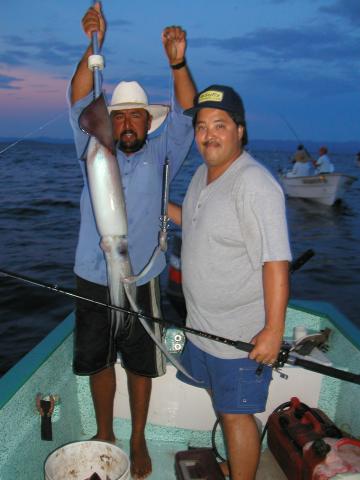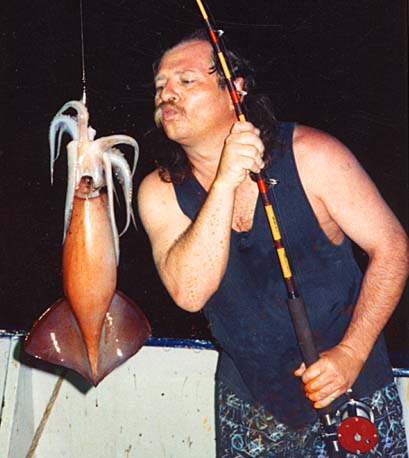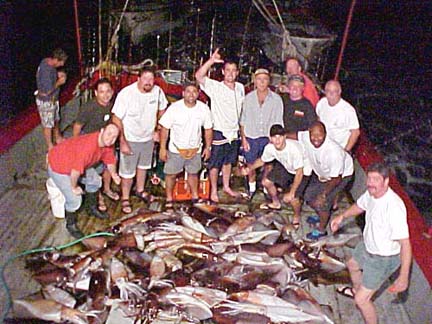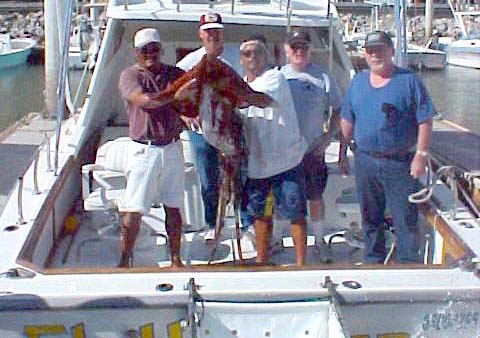
Giant Humboldt Squid: Scary Squid Stories
![]()
|
|
GIANT SQUID: LORE AND FACT IN THE WORLD OF THE HUMBOLDT SQUID
By Gene Kira, Aug. 15, 2002, as published in Western Outdoors Magazine:
Every year, it seems, at least a few "giant squid" wash up dead on Southern California beaches, and our local television reporters go down to the sea and do some stories on the stinky phenomenon.
Inevitably, the "monster squid" in question turns out to be a puny, 20 or 30-pound example of what we catch in Baja California waters all the time--the Humboldt squid, first described by biologists in the mid-1800s.
It's no wonder that this strange animal, Dosidicus gigas, draws a lot of attention, but what most people don't realize is that squid are actually quite common. In fact, some biologists guess that the over 300 squid species constitute the largest biomass of any animal group. If you're talking about sheer tonnage, squids may be the most successful species on our planet.
|
|
In Baja, our Humboldt squid can get to be about 100 pounds in weight (and that's a dang big plate of calamari), but usually, about 50 pounds is the maximum. Most of the Humboldts we catch with our foot-long "squid jigs" weigh about 10 to 30 pounds, and even at that size, they give you a surprising fight on rod and reel, especially if they decide to blast you in the face with a shower of black ink, or cut loose with a body-full of jet-propulsion water that can go shooting 20 feet in the air like a geyser. These giant cephalopods can create a lot of jokes and laughter on a boat, but they are also a real sport "fish." A 50-pounder is a memorable experience, and I don't even want to think about trying to subdue a 100-pounder without a seat belt, face mask, and plenty of hand grenades.
Baja is actually at the northern edge of the Humboldt squid's distribution range. They are most common and largest off the coast of South America, where they can grow up to about 16 feet long and weigh several hundred pounds.
Although they look flaccidly impotent when laid out dead on the deck, when alive in the water, Humboldt squid are powerful, vicious, meat-eating predators, and they are very dangerous to swim near. Around Baja, more gruesome stories are told about people getting killed by squid than by any other sea creature. Imagine a swarm of 50-pound animals capable of swimming more than 20 miles-per-hour, equipped with voracious appetites and over 1,000 suckers, each containing about 20 gripping teeth strong enough to tear human skin (correct, that's 20,000 teeth!). And, surrounded by that cluster of four-foot long arms is a powerful parrot's beak the size of a small tangerine, snapping and cutting at anything pulled within its reach.
In Baja, the typical "diablo" squid story involves a hapless fisherman who is suddenly caught and pulled overboard while night fishing commercially with lights. Within a couple of seconds, his entire body is literally covered with clinging, biting squid that quickly pull him down into the dark and tear him to pieces before anybody can help.
|
|
But like the medieval vision of Lucifer, this devil can play tricks that make it appear incredibly beautiful at times. Squids have some of the most highly developed nervous systems in nature, and their chromatosphore-covered skin is capable of dazzling, vibrating color displays, flashing in fractions of a second, back-and-forth, say, between red and white stripes, and bluish-green polka dots. Sometimes, the whole animal vibrates in unison, and sometimes the colors move across its body in shimmering waves. It's amazing.
The first Humboldt squid I ever saw had washed ashore near Bahia de los Angeles' Punta la Gringa camping area, and it was still alive. As I struggled to pull it up on the gravel, I noticed that I was leaving yellow hand prints on its reddish-brown skin. As it flopped about in its death throes, I discovered that I could write my name on its body with the tip of my finger, and the letters would remain there, flashing different colors, for several minutes.
Later that morning, we launched into a heavy fog, and just off Horse Head Island we ran into a full-on, daytime feeding frenzy of squid on the surface. They would zoom upwards beneath our boat and open their vividly-colored arms to engulf any lure that was dangled above the water for them. It was like being surrounded by a macabre field of enormous, carnivorous, blooming flowers. Amazing. I don't think I would have wanted to run into that on a kayak.
|
|
However, the really scary squid isn't our Humboldt squid at all, but another species that truly is gigantic, the Architeuthis sp., that ranges to tremendous depths throughout the ocean abysses of the world and is the stuff of legends so old that it may have been the model for the Scylla of Homer's Odyssey, the Kraken of Norse mythology, and of course, the gigantic, Capt. Nemo-attacking squid of Jules Verne's 20,000 Leagues Under the Sea.
Fascinatingly, this Architeuthis has never been scientifically observed while alive in its natural habitat. Our scanty knowledge of this, the largest of all invertebrates, comes from about 100 dead specimens washed ashore per century, a few caught in trawling nets, and a handful of anecdotal encounters by ships attacked at sea, sailors, fishermen, and survivors of shipwrecks. Sperm whale stomachs also provide ample evidence of this giant squid's prevalence in the unknown depths, as they often contain numbers of its indigestible, grapefruit-sized beaks.
What is known about Architeuthis is that it lives thousands of feet deep, can weigh well over a ton, and grow at least 70 feet long, including its arms (some accounts give it a length more than twice that). It's eyeballs, the largest of any animal that has ever lived, have been measured at 16 inches in diameter. The sucker marks that it leaves on the skins of sperm whales have been described as "dinner plate" sized. Judging by the ferociousness and power of our own relatively humble, Humboldt squid, this Kraken, or Scylla, or whatever you want to call it, must surely be one of the most fearsome predators of the sea, when it is alive and healthy in its own, completely dark environment.
In Baja, our Humboldt squid has become an important commercial product, and huge fleets of pangas can been seen working with lights at night from the Midriff area south to Loreto. It's a low-paying product, but expenses are also low because the pangas only have to go out a mile or so, and the voracious squid are easily hauled in by the hundreds with hand lines and jigs. The center of this commercial activity is in the Santa Rosalia area where several packing houses work to fill the orders of Asian buyers.
But ironically, for us sport anglers, the delicious squid, or calamari (try it hickory smoked sometime!), is an officially forbidden pleasure. Mexican sport fishing regulations--so often ignored by Mexicans and Americans alike--actually prohibit the sport catching of squid, even though many thousands are openly taken each year, and charter fishing operators advertise them as part of the anticipated catch. Tons of squid are also cut up each year as fish bait, with no problems from local field inspectors.
Someday, perhaps, someone in Mexico will decide to enforce the regulations and this happy state of benign, squidly neglect may come to an end. But until then, the delicious, formidable, and abundant Humboldt squid will continue to provide Baja sport anglers with excellent bait, delightful calamari meals, and lots of "Baja stories"--both humorous and scary.
|
|
(Related Baja California, Mexico, articles and reports may be found at Mexfish.com's main Baja California information page. See weekly fishing news, photos, and reports from the major sportfishing vacation areas of Mexico including the Baja California area in "Mexico Fishing News.")
MEXICO FISHING INFO BAJA FISHING INFO "WEEKLY MEXICO FISHING NEWS" FISH PHOTO GALLERY





